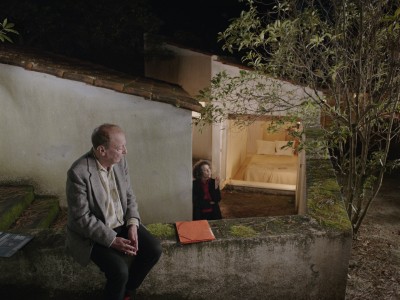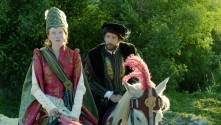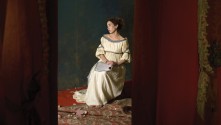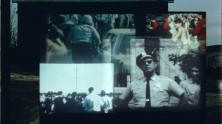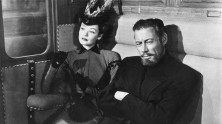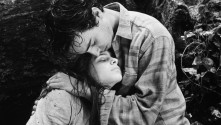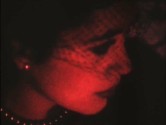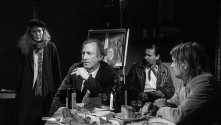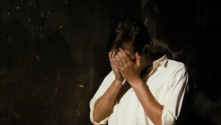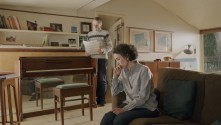
La vie de bohème
With Matti Pellonpää, Evelyne Didi, André Wilms.
Finland/France, 1992, 35mm, black & white, 103 min.
French with English subtitles.
Print source: Janus Films
Si je désire une eau d’Europe, c’est la flache / Noire et froide où vers le crépuscule embaumé / Un enfant accroupi plein de tristesse, lâche / Un bateau frêle comme un papillon de mai. – from "Le Bateau ivre," Arthur Rimbaud
This film was for me a very recent and total discovery. Ironically, it has always escaped me, even despite the cycle of Kaurismäki at the Cinemateca Portuguesa in 2000 for which I designed the catalog. As soon as I heard the opening song about the night image of the rooftops of Paris (always the unequaled photography—and in black and white!—by Timo Salminen), I spontaneously let myself be pulled into the movie. All the way to the end!
The entire film unfolds to the rhythm of a melody—a melody that is intimately Kaurismäkian. Everything is so pure in this melancholy story, brilliantly nipped by a lapidary irony. In a Paris filmed behind the facade; in a deliberately imprecise era, we enter the lives of these three artists, companions of misfortune: a writer, Max; a painter, Rodolfo; and Schaunard, a musician. It is curious that the origin of the film was precisely a writer (Henri Murger, author of Scènes de la vie de bohème, which Puccini adapted for his famous opera. "My desire was to take revenge on Puccini, who is generally considered the father of this wonderful story," Aki Kaurismäki comments in the film's press book), and that there was also, in a way, the role of the musician in the music that Kaurismäki offers us in perfect harmony with the image. Finally, there was also a painter, the image-maker: Rodolfo/Kaurismäki?
Kaurismäki's art always goes hand in hand with cinema and its history. En fermant les yeux, Je voudrais retrouver, les moments joyeux de mon tendre passé éffacé..., cries the opening song. Are not the appearances of Samuel Fuller and Jean-Pierre Léaud testimony to this? But not only. Aki Kaurismäki appropriates all kinds of cinematic clichés to transpose them into his filmic context, such as the lush flowers that die with a simple fade to black.
Then there is Mimi, the tragic figure with hopeless eyes to whom Rodolfo, the painter, offers everything without asking, like an angel. "Why don't you come and live with me, Mimi? I'll clean the house so you can watch the park from the window. In the evening we'll go to the opera." But Mimi ends up becoming sick, she will die... For the three friends there will be long questions, vast pauses, in long, long silences. And then there is the black dog, Baudelaire, the subject of one of Rodolfo's most moving paintings.
Like the floating grasses, Kaurismäki's characters are an invented artifice. But the people who shape them are the realest of realities. They derive from a life without meaning, without direction, without end. Or rather, with an endless end such as this one, when Rodolfo goes on alone with his Baudelaire and suddenly another dog bursts in and follows them to disappear with them into the darkness.... How can we not think of Mimi? And how can you not think of a certain Cinema that Aki incessantly, and “doggedly,” pursues? – RA
------------------------------------------
Este filme foi para mim uma recentíssima e total descoberta. Por qualquer ironia este filme escapou-me sempre, apesar do ciclo na cinemateca em 2000 para o qual eu própria desenhei o catálogo.
Mal se ouviu a canção inicial sobre a imagem nocturna dos telhados de Paris, (sempre a ímpar fotografia – e a preto e branco! – de Timo Salminen) espontaneamente me deixei arrastar para o interior do filme. Até ao fim!
Todo o filme prossegue ao ritmo de uma melodia; uma melodia intimamente Kaurismäkiana. Tudo é tão puro nesta história melancólica e brilhantemente beliscada por uma ironia lapidar. Numa Paris filmada por detrás da fachada; numa época deliberadamente imprecisa, entramos na vida desses três artistas, companheiros do infortúnio: um escritor, Max; um pintor, Rodolfo e Schaunard, um músico.
Curioso que na origem do filme estivesse precisamente um escritor (Henri Murger, autor de Scènes de la vie de bohème, que Puccini adaptou para a famosa ópera. “O meu desejo era vingar-me de Puccini, que na consciência geral é tido como o pai desta história maravilhosa”, comentário de Aki Kaurismäki no press book do filme), e que estivesse também, de certa forma, o papel do músico na(s) música(s) que Kaurismäki nos oferece em harmonia perfeita com a imagem e por fim havia igualmente um pintor, o fabricador de imagens: Rodolfo/Kaurismäki?
A arte de Kaurismäki anda sempre a par com o cinema e sua história. En fermant les yeux, Je voudrais retrouver, Les momenst Joyeux de mon tendre passé éffacé…, diz-nos a canção inicial. Não serão as aparições de Samuel Fuller e Jean-Pierre Léaud testemunho disso? Mas não só. Aki Kaurismäki apropria-se de todo o tipo de clichés cinematográficos para os transpor para o seu contexto fílmico, como as flores viçosas que acabam por morrer com um simples desvanecer a negro da imagem.
Depois, surge Mimi, a figura trágica de olhos desesperançados a quem Rodolfo, o pintor, tudo oferece sem nada pedir, como um anjo. “Porque não vens viver comigo, Mimi? Limpo eu a casa para que tu possas ficar a ver o parque pela janela. À noite iremos à opera.” Mas Mimi acaba por adoecer, irá morrer... Para os três amigos ficarão longas perguntas, vastas pausas, em longos, longos silêncios.
E há o cão preto, Baudelaire, motivo de um dos quadros mais comoventes de Rodolfo.
À semelhança de ervas flutuantes os personagens de Kaurismäki são um artifício inventado. Mas as pessoas que lhes dão forma são a mais real das realidades. Derivam numa vida sem sentido, sem rumo, sem fim. Ou antes, com um fim infindável como este, quando Rodolfo segue sozinho com o seu Baudelaire e, de repente, outro cão irrompe e os segue para com eles desaparecer na escuridão... Como não pensar em Mimi? E como não pensar num certo Cinema que Aki persegue incessantemente? – RA
The openly theatrical artifice driving Azevedo Gomes’ finest work is showcased in this short film commissioned by the cultural office of the eponymous city. When two couples, strangers, are asked to share a table in a crowded hotel restaurant their conversation gives way to a rambling version of how Portugal won the city of Faro and, in turn, the Algarve region from the Moors through a series of, in Azevedo Gomes’ words, “double betrayals.” Um filme falado, or a talking picture, that is partially dreamed by one of the characters, The Conquest of Faro was written by Agustina Bessa-Luís, the celebrated Portuguese novelist and frequent screenwriter for Manoel de Oliveira. The film ends with a poignantly extended and enigmatic image, a lush painterly shot of a donkey standing at night by the roadside.

